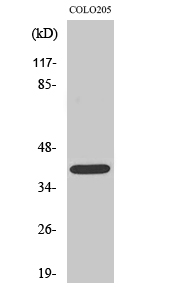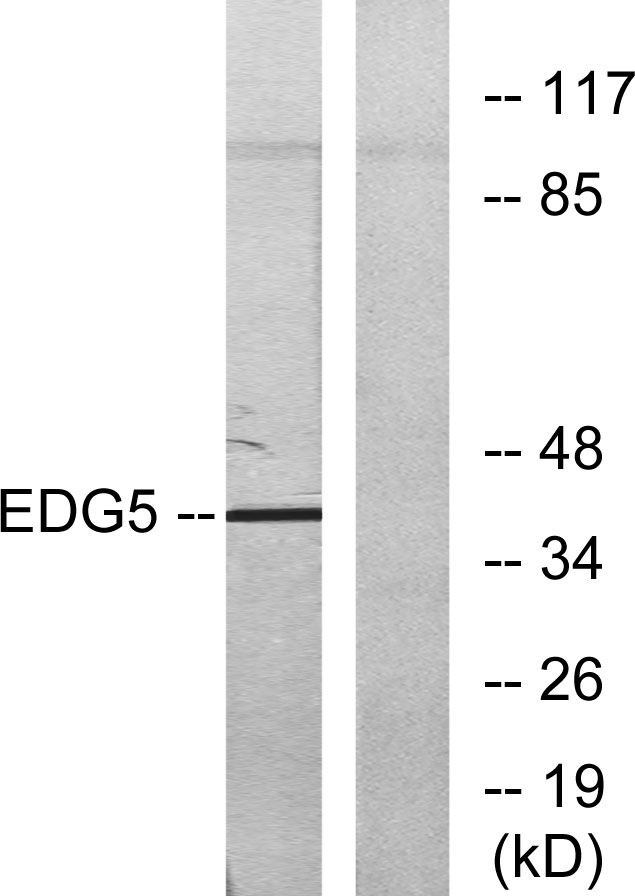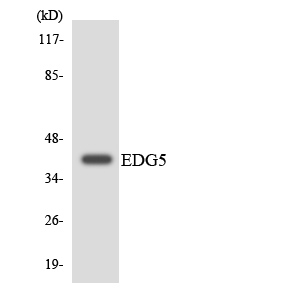EDG-5 Polyclonal Antibody
- Catalog No.:YT1467
- Applications:WB;IHC;IF;ELISA
- Reactivity:Human;Mouse;Rat
- Target:
- EDG-5
- Fields:
- >>Sphingolipid signaling pathway;>>Neuroactive ligand-receptor interaction
- Gene Name:
- S1PR2
- Protein Name:
- Sphingosine 1-phosphate receptor 2
- Human Gene Id:
- 9294
- Human Swiss Prot No:
- O95136
- Mouse Gene Id:
- 14739
- Mouse Swiss Prot No:
- P52592
- Rat Gene Id:
- 29415
- Rat Swiss Prot No:
- P47752
- Immunogen:
- The antiserum was produced against synthesized peptide derived from human EDG5. AA range:261-310
- Specificity:
- EDG-5 Polyclonal Antibody detects endogenous levels of EDG-5 protein.
- Formulation:
- Liquid in PBS containing 50% glycerol, 0.5% BSA and 0.02% sodium azide.
- Source:
- Polyclonal, Rabbit,IgG
- Dilution:
- WB 1:500 - 1:2000. IHC 1:100 - 1:300. IF 1:200 - 1:1000. ELISA: 1:10000. Not yet tested in other applications.
- Purification:
- The antibody was affinity-purified from rabbit antiserum by affinity-chromatography using epitope-specific immunogen.
- Concentration:
- 1 mg/ml
- Storage Stability:
- -15°C to -25°C/1 year(Do not lower than -25°C)
- Other Name:
- S1PR2;EDG5;Sphingosine 1-phosphate receptor 2;S1P receptor 2;S1P2;Endothelial differentiation G-protein coupled receptor 5;Sphingosine 1-phosphate receptor Edg-5;S1P receptor Edg-5
- Observed Band(KD):
- 39kD
- Background:
- This gene encodes a member of the G protein-coupled receptors, as well as the EDG family of proteins. The encoded protein is a receptor for sphingosine 1-phosphate, which participates in cell proliferation, survival, and transcriptional activation. Defects in this gene have been associated with congenital profound deafness. [provided by RefSeq, Mar 2016],
- Function:
- function:Receptor for the lysosphingolipid sphingosine 1-phosphate (S1P). S1P is a bioactive lysophospholipid that elicits diverse physiological effect on most types of cells and tissues. When expressed in rat HTC4 hepatoma cells, is capable of mediating S1P-induced cell proliferation and suppression of apoptosis.,similarity:Belongs to the G-protein coupled receptor 1 family.,
- Subcellular Location:
- Cell membrane; Multi-pass membrane protein.
- Expression:
- Fetal brain,
Salidroside Inhibits CCl4-Induced Liver Fibrosis in Mice by Reducing Activation and Migration of HSC Induced by Liver Sinusoidal Endothelial Cell-Derived Exosomal SphK1. Frontiers in Pharmacology Front Pharmacol. 2021 May;0:1195 WB Mouse,Human Liver,serum exosomes
Integration of metabolomics and transcriptomics analyses reveals sphingosine-1-phosphate-mediated S1PR2/PI3K/Akt pathway involved in Talaromyces marneffei infection of macrophages MICROBIAL PATHOGENESIS Yi-Qun Kuang WB,IHC Mouse lung J774A.1 macrophages
- June 19-2018
- WESTERN IMMUNOBLOTTING PROTOCOL
- June 19-2018
- IMMUNOHISTOCHEMISTRY-PARAFFIN PROTOCOL
- June 19-2018
- IMMUNOFLUORESCENCE PROTOCOL
- September 08-2020
- FLOW-CYTOMEYRT-PROTOCOL
- May 20-2022
- Cell-Based ELISA│解您多样本WB检测之困扰
- July 13-2018
- CELL-BASED-ELISA-PROTOCOL-FOR-ACETYL-PROTEIN
- July 13-2018
- CELL-BASED-ELISA-PROTOCOL-FOR-PHOSPHO-PROTEIN
- July 13-2018
- Antibody-FAQs
- Products Images

- Western Blot analysis of various cells using EDG-5 Polyclonal Antibody

- Western blot analysis of lysates from COLO205 cells, using EDG5 Antibody. The lane on the right is blocked with the synthesized peptide.

- Western blot analysis of the lysates from RAW264.7cells using EDG5 antibody.



